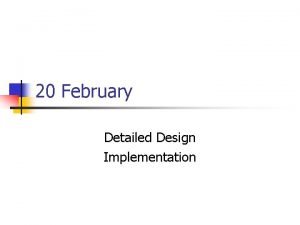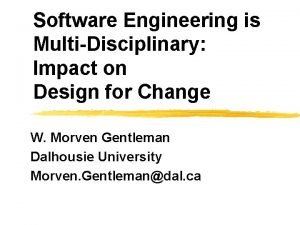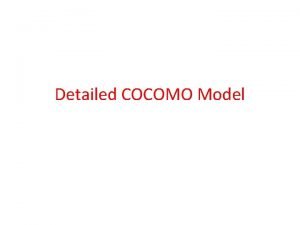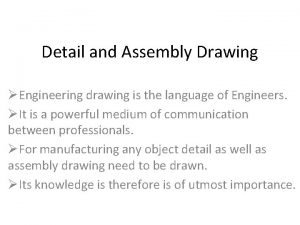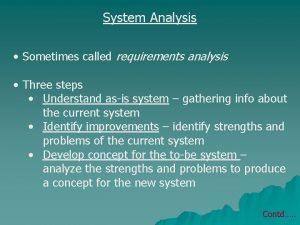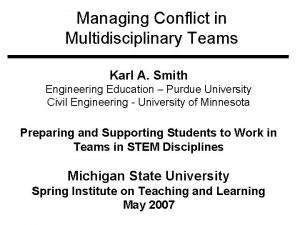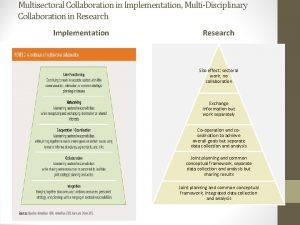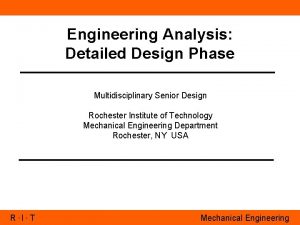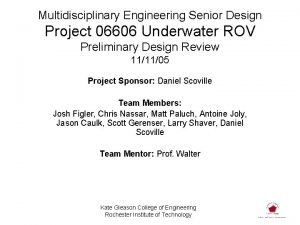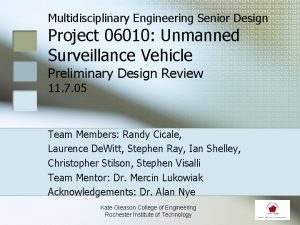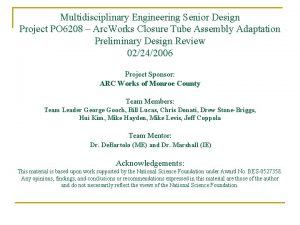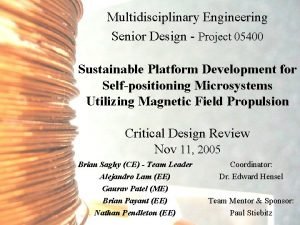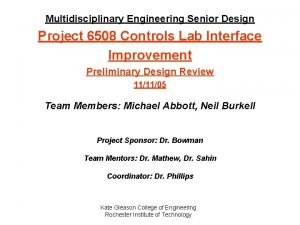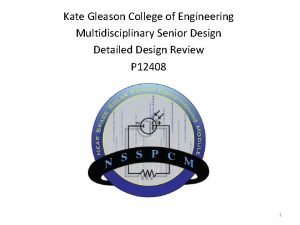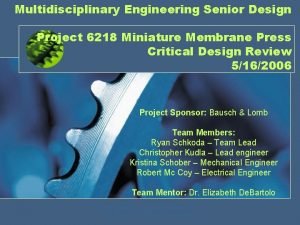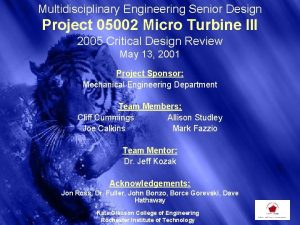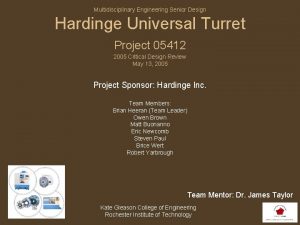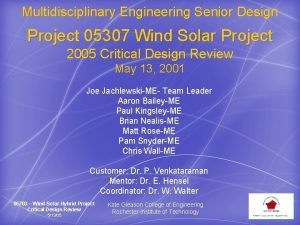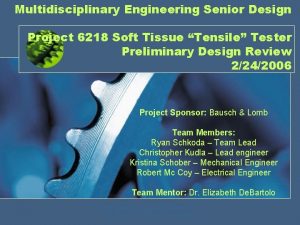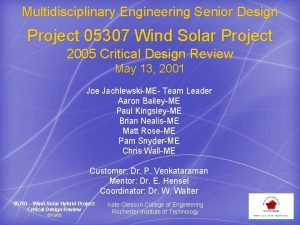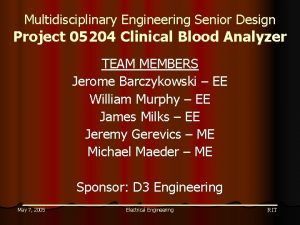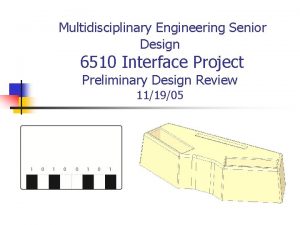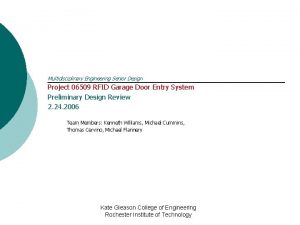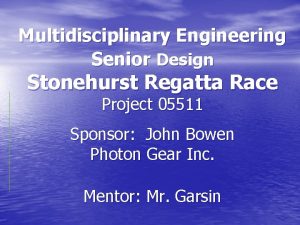Engineering Analysis Detailed Design Phase Multidisciplinary Senior Design























- Slides: 23

Engineering Analysis: Detailed Design Phase Multidisciplinary Senior Design Rochester Institute of Technology Mechanical Engineering Department Rochester, NY USA R. I. T Mechanical Engineering

Try this: • In the next 2 minutes, estimate the distance defined by “shoulder-height with respect to the ground outside”. • ~1 minute: develop analysis plan • ~1 minute: analyze • You MUST have an answer in 2 minutes, but it doesn’t have to be right – just a decent guess. R. I. T Mechanical Engineering

Before we go into answers… • Who was unhappy about having to come up with a solution in 2 minutes? • Who came up with a solution in 2 minutes? R. I. T Mechanical Engineering

Before we go into answers… • What approach did you take? • What questions did you ask yourself? R. I. T Mechanical Engineering

Before we go into answers… • What approach did you take? • • (estimate floor height x 2) + shoulder height? (estimate step height x # steps) + shoulder height? Envision # people you could stack off the balcony? Something else? • What questions did you ask yourself? • • R. I. T Whose shoulders? Which ground? Something else? Does it matter? Mechanical Engineering

The most important questions: Why do you ask? or What do you want to learn from my answer? R. I. T Mechanical Engineering

This is first-order analysis! • Dr. Amuso discussed this already. • Appropriate for systems-level design phase • “Does this solution even remotely make sense? ” • “Is there any feasible solution to the problem before us? ” • “Will it cost $1, $10, or $100? ” R. I. T Mechanical Engineering

Today: higher-order analysis • Appropriate for detailed design phase • Bigger time investment • Analysis involves more parameters • Don’t want to do this for ALL designs, just the most promising one (or maybe two). • (Potentially) better results • Include more effects -> more accurate • Need to know more about the problem R. I. T Mechanical Engineering

What type of analysis, and when? • Look at a few possible scenarios. • How in-depth should the analysis be? • What information is important to the analysis? • What will you learn by doing each analysis? R. I. T Mechanical Engineering

Possible Scenarios: I am designing a system to drop a quarter, from my outstretched arms, off the 4 th floor balcony. My friend needs to do laundry and asked to borrow a quarter. R. I. T Mechanical Engineering

Possible Scenarios: I am designing a system to drop a quarter, from my outstretched arms, off the 4 th floor balcony. It has to reach the ground in less than 0. 5 sec and land within 1 m of my friend. (Gotta dress up for an interview in 20 minutes!) R. I. T Mechanical Engineering

Possible Scenarios: I am designing a system to drop a quarter, from my outstretched arms, off the 4 th floor balcony. It has to reach the ground in less than 0. 5 sec and land within 1 cm of my friend. (No time to waste hunting around for it – that shirt is wrinkling in the dryer as we speak!) R. I. T Mechanical Engineering

“My friend needs to do laundry and asked to borrow a quarter. ” The analysis we’ve already done is fine. More than enough. R. I. T Mechanical Engineering

“It has to reach the ground in less than 0. 5 sec and land within 1 m of my friend. ” Need to know: terminal velocity of a quarter, height to within ~1 ft, amount of time consumed by release mechanism R. I. T Mechanical Engineering

It has to reach the ground in less than 0. 5 sec and land within 1 cm of my friend. ” Need to know: terminal velocity of a quarter, height to within ~1 ft, amount of time consumed by release mechanism And local terrain variation, wind speed, orientation of quarter @ drop… R. I. T Mechanical Engineering

Lesson learned: • Not all analysis require you to know average daily wind speed and the terminal velocity of a quarter at sea level. Figure out how accurate your analysis must be before you start. • You may not know all the variables before you start. Iterate, or use model to evaluate different design options R. I. T Mechanical Engineering

Example: one student’s work on one subsystem of a design System weight: 44 lb Footplates: 8. 7 lb! Customer: “Reduce weight, reduce cost, increase functionality” R. I. T Mechanical Engineering

Problem Definition Footplates fall under “support patient” function. (Component #3). Three Engineering Requirements will be met in whole or in part by the footplates. R. I. T Mechanical Engineering

Systems-Level Design Simple spreadsheet analysis of representative loading scenario allows the team to evaluate different materials and thicknesses. This is generous on the assumptions, but lets us compare options in an educated manner. R. I. T Mechanical Engineering

Detailed Design Weight distribution across a footprint? ? ? Collect some benchmark data on deflection under load: dial indicator, corner supports, and a willing 250 lb volunteer. Use this information to calibrate a finite element model. R. I. T Mechanical Engineering

Detailed Design THEN, evaluate different material removal options using ANSYS. FINALLY, predict performance vs. spec for the proposed design. R. I. T Mechanical Engineering

Lessons Learned • Assumptions/boundary conditions matter • A little bit of judicious prototyping or experimentation can be a huge help • Use your analysis to make design decisions and to predict performance vs. spec. R. I. T Mechanical Engineering

Questions? R. I. T Mechanical Engineering
 Detailed design in software engineering
Detailed design in software engineering Multidisciplinary software development team
Multidisciplinary software development team Cocomo model example
Cocomo model example Cross halving joint diagram
Cross halving joint diagram Analysis is sometimes called
Analysis is sometimes called What is function oriented design in software engineering
What is function oriented design in software engineering Multidisciplinary nature of environmental studies;
Multidisciplinary nature of environmental studies; Multidisciplinary team pros and cons
Multidisciplinary team pros and cons Temasek laboratories
Temasek laboratories Multidisciplinary vs interdisciplinary
Multidisciplinary vs interdisciplinary Examples of transdisciplinary approach
Examples of transdisciplinary approach Multidisciplinary nature of environmental studies ppt
Multidisciplinary nature of environmental studies ppt Conflict in multidisciplinary teams
Conflict in multidisciplinary teams Multisectoral and multidisciplinary
Multisectoral and multidisciplinary Interdisciplinary multidisciplinary transdisciplinary
Interdisciplinary multidisciplinary transdisciplinary Epcc degree plans
Epcc degree plans Normal phase vs reverse phase chromatography
Normal phase vs reverse phase chromatography Tswett pronunciation
Tswett pronunciation Mobile phase and stationary phase
Mobile phase and stationary phase Mobile phase
Mobile phase Normal phase vs reverse phase chromatography
Normal phase vs reverse phase chromatography Line current and phase current
Line current and phase current Which detector used in hplc
Which detector used in hplc In a ∆-connected source feeding a y-connected load
In a ∆-connected source feeding a y-connected load
